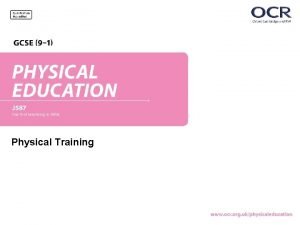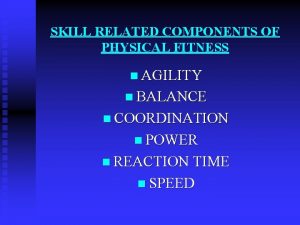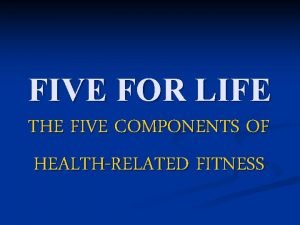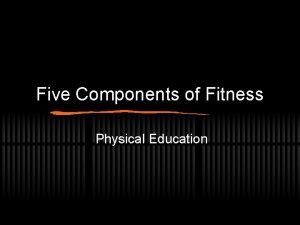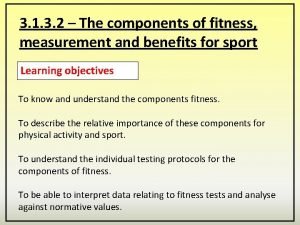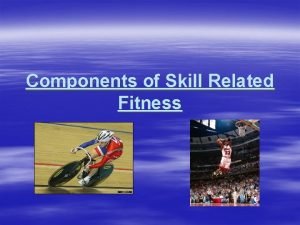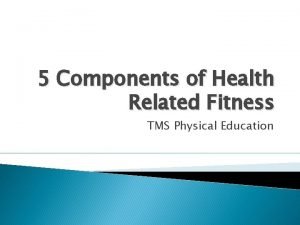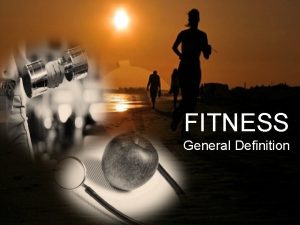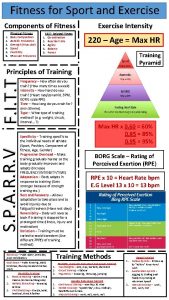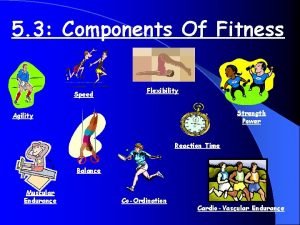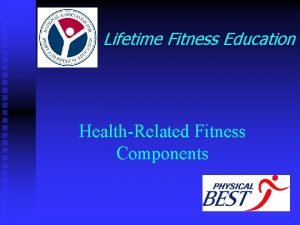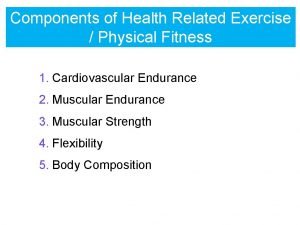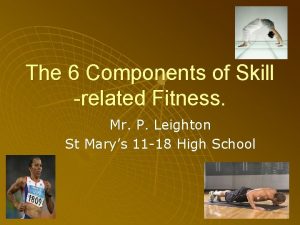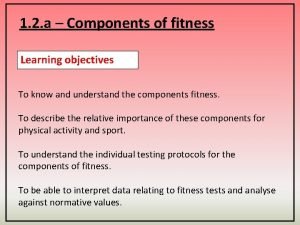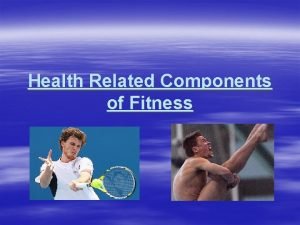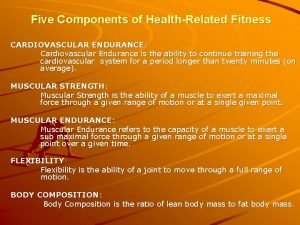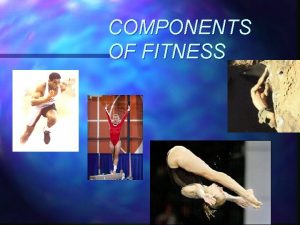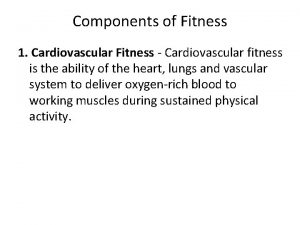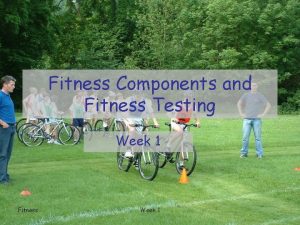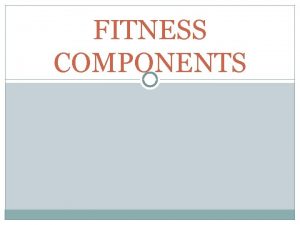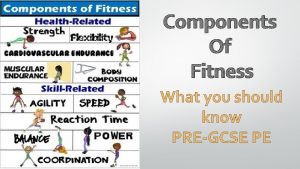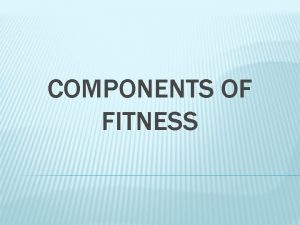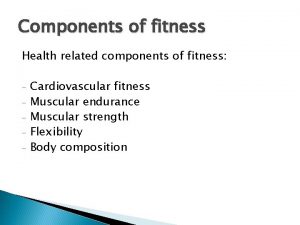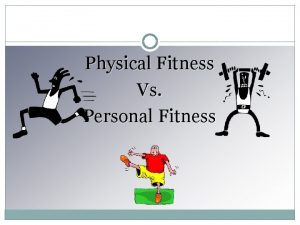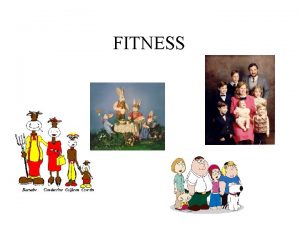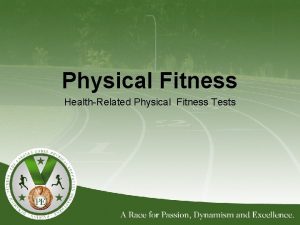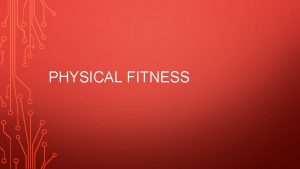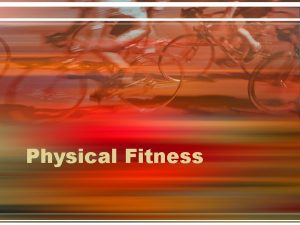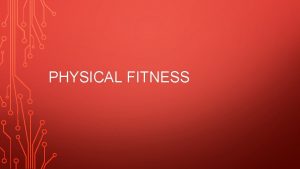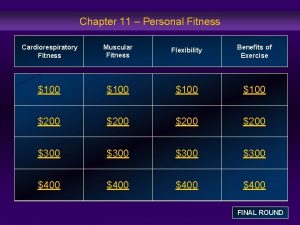3 1 3 2 The components of fitness


















































- Slides: 50

3. 1. 3. 2 – The components of fitness, measurement and benefits for sport Learning objectives To know and understand the components fitness. To describe the relative importance of these components for physical activity and sport. To understand the individual testing protocols for the components of fitness. To be able to interpret data relating to fitness tests and analyse against normative values.

Components of fitness Every sport requires different components of fitness depending on the demands of that event. Remember components of fitness can be used separately or in combination with each other.

Agility Athletes with good AGILITY keep their entire body under control throughout. Agility is especially important in sports that require a sharp movement or turn. i. e. goal keeper Definition: “is the ability to change direction with speed”

Balance can be static (i. e. handstand) or dynamic (i. e. keeping your balance on a skateboard or while surfing) Definition: “is the ability of the performer to retain their centre of mass over their base of support without falling”

Cardiovascular Endurance (Aerobic Power) The cardio-respiratory system deals with the heart, lungs and blood vessels of the body. Definition: “The ability of the heart and circulatory system to meet the demands of the body for a long period of time”

Coordination may be advantageous to tennis player in producing an effective tennis stroke, coordinating footwork and arm action. Definition: “is the ability to move two or more body parts at the same time” Discuss other sporting events that require coordination.

Flexibility Also known as suppleness refers to the ability of the muscles to stretch and then return to their original position. It is important for reducing the risk of muscles strains and injuries. Definition: “The range of movement at a joint”

Muscular Endurance Also known as stamina means that the muscles keep working for a long time without getting tired. This component of fitness is essential for long distance events. Definition: “The ability to use voluntary muscles, over long periods of time without getting tired”

Power/explosive strength (anaerobic power) Power is a combination of strength and speed. Power is important in explosive events like throwing and sprinting. Power is vital to getting a good start in short races. Definition: “Speed x Strength”

Reaction Time Reaction time is a response to a stimulus. This could be anything from a starting gun to a sudden side-step by an opponent. Definition: “The time between the presentation of a stimulus and movement” Discuss how a table tennis player requires reaction time to succeed.

Strength is required for a range of athletes. Definition: “The ability to exert a large amount of force in a single maximum effort” Discuss what sporting events would benefit from a high level of muscular strength.

Strength A sportsperson uses different types of strength depending on the type of action required. Dynamic Strength: This type of strength is used in events that take a long period of time to complete. i. e. Rowing action Maximal strength: The greatest force that is possible in a single maximum contraction

Strength Explosive Strength: This type of strength comes about when a burst of maximum effort is required. e. g. Kicking a ball or striking a tennis ball during a groundstroke Static Strength: Static strength takes place when the muscle length stays the same. It is used to stabilise the body. e. g. A rugby scrum

Speed is very important in many sports in a number of ways. Speed is key in a 100 m sprint race or it may aid a sporting action. (i. e. a badminton player producing a quick overhead clear may be too powerful to return) Definition: “Time taken to cover a set distance”

Fitness Testing There are tests for each type of fitness. Fitness testing measures a performer's ability and is beneficial to both the performer and the coach in highlighting areas for improvement. Fitness testing will: • Highlight strengths and weaknesses • Allow progress to be monitored carefully, through re -testing and comparison to norms • Help in talent identification

Fitness Testing Fitness testing is vital for athletes to monitor and assess improvements in performance. This is important for goal setting and motivation. The results should be used to design a specific training programme that works on the performers area of weakness.

Fitness Testing Once results are collected they will need interpreting against a set of published standardised readings. Evaluating the testing procedure is also important. Consider the terms below. What do they mean? Reliability, Validity, Practicality

Fitness Testing Validity relates to whether the test actually measures what it sets out to measure. Reliability is a question of whether the test is accurate. It is important to ensure that the procedure is correctly maintained for ALL individuals. How might you improve validity and reliability?

Fitness Testing Validity, reliability & practicality can be improved by: • Being undertaken by experienced testers • Equipment being calibrated • Ensuring performers have the same level of motivation to complete the test to the best of their ability. • Testing repeatedly to avoid human error.

Limitations of fitness testing Fitness testing can also have its limitations and some of the drawbacks are listed below: • Tests are often too general. • They do not replicate movements of the activity. • They do not replicate competitive conditions required in sports. • Useless the subjects are fully motivated reliability can be questionable. • They must be carried out with the correct procedures to increase validity.

Fitness Tests Illinois Agility Test for Agility Measures the agility of the performer as well as speed. Protocol: Performers start at the first cone. On the whistle pupils should follow the course in the diagram and finish at the end cone. Performers are timed from start to finish.

Fitness Tests Here is a table of the average scores: Gender Male Female Excellent <15. 2 secs <17. 0 secs Above Average 15. 2 - 16. 1 secs 17. 0 - 17. 9 secs Average 16. 2 - 18. 1 secs 18. 0 - 21. 7 secs Below Average 18. 2 - 19. 3 secs 21. 8 - 23. 0 secs Poor >19. 3 secs >23. 0 secs

Fitness Tests Stork Balance Test for Balance Measures the development of the athlete's ability to maintain a state of equilibrium (balance) in a static position. Protocol: • Athlete lifts the right leg, places the sole of the right foot against the side of the left kneecap. The athlete raises the heel of the left foot to stand on their toes. • The athlete is timed holding this position for as long as possible.

Fitness Tests Here is a table of the average scores: Rating Males (seconds) Females (seconds) Excellent >50 >30 Above Average 41 -50 23 -30 Average 31 -40 16 -22 Below Average 20 -30 10 -15 Poor <20 <10

Fitness Tests Multi Stage Fitness Test for Cardiovascular Endurance (Aerobic Power) This test is a indication of a performer’s Cardiovascular endurance and can be used to estimate VO 2 max. Protocol: • 20 metre distance to be marked out with cones. • Athlete must arrive at the cone before the beep and wait. On the beep the athlete can resume running. The level and number of shuttles are recorded.

Fitness Tests Multi Stage Fitness Test for Cardiovascular Endurance (Aerobic Power) Here is a table of the normative data: Men (level/shuttle) Women (level/shuttle) Excellent L 12 S 7 and > L 10 S 9 and > Above average L 11 S 2 L 9 S 1 Average L 8 S 9 L 6 S 7 Below average L 7 S 1 L 5 S 1 Poor < L 6 S 6 < L 4 S 7

Fitness Tests Wall toss test for Coordination The test is designed to monitor the ability of the athlete's vision system to coordinate the information received. Protocol: • Athlete is to stand 2 metres from a wall. • A tennis ball is thrown with their right hand against the wall and caught with the left hand. The ball is then thrown with the left hand caught with the right hand. • This cycle of throwing and catching is repeated for 30 seconds. The number of catches is recorded.

Fitness Tests Wall toss test for Coordination Here is a table of the normative data: Age Excellent 15 -16 years >35 Above Average 30 - 35 Average 25 - 29 Below Average 20 - 24 Poor <20

Fitness Tests Sit and Reach Test for Flexibility Measures the range of movement at the hips/torso. Protocol: • Legs straight with feet touching the box. • Push marker as far as possible without bending your knees.

Fitness Tests Sit and Reach Test for Flexibility Here is a table of the normative data for a sit and reach test: Gender Excellent Male Female >14 >15 Above average 11 - 14 12 - 15 Average 7 - 10 7 - 11 Below average 4 -6 Poor <4 <4

Fitness Tests Sit-Up Bleep Test for Muscular Endurance The sit-up bleep test assesses muscular endurance of the abdominals. Protocol: • Athlete performs sit ups in time with the bleep test signals to the point of exhaustion. • The level of fitness reached depends on the level reached.

Fitness Tests Sit-Up Bleep Test for Muscular Endurance Here is a table of the normative data: Stage 1 2 3 4 5 6 7 8 Number of sit ups Cumulative 20 42 64 89 116 146 180 217 Male Poor Fair Good Very Good Excellent Female Poor Fair Good Very Good Excellent

Fitness Tests Vertical Jump Test for Power/Explosive Strength Protocol: • Performers to reach up to highest point without going onto tiptoes. • Jump vertically and touch highest point on the wall/board. • The score is the difference between the 2 measurements

Fitness Tests Vertical Jump Test for Power/Explosive Strength Here is a table of the normative data: Gender Male Female Excellent >65 cm >58 cm Above average 50 - 65 cm 47 - 58 cm Average 40 - 49 cm 36 - 46 cm Below average 30 - 39 cm 26 - 35 cm Poor <30 cm <26 cm

Fitness Tests Ruler Drop Test for Reaction Time The ruler drop test monitors an athlete's reaction time to a stimulus. Protocol: • A ruler is held by the assistant between the outstretched index finger and thumb of the athlete's dominant hand. • Ensure the top of the thumb is level with the zero centimetre line on the ruler. • Ruler is released and measurement (cm) is taken from the point caught on the ruler.

Fitness Tests Ruler Drop Test for Reaction Time Here is a table of the normative data: Excellent Above Average Below Average Poor <7. 5 cm 7. 5 - 15. 9 cm 15. 9 - 20. 4 cm 20. 4 - 28 cm >28 cm

Fitness Tests One Rep Max Test for Maximal Strength This test measures the maximum strength of various muscle groups. Protocol: • Athlete should attempt to perform one full repetition of the stated exercise at the highest possible weight. • The weight should be recorded.

Fitness Tests 30 m Sprint Test for Speed Protocol: • Performers to cover a straight 30 m from a standing start. • The time taken should be accurately recorded.

Fitness Tests 30 m Sprint Test for Speed Here is a table of the normative data: Time to run 30 meters (in seconds) Rating Men Very good < 4. 80 Good 4. 80 - 5. 09 Average Fair Poor 5. 10 - 5. 29 5. 30 - 5. 60 > 5. 60 Women < 5. 30 - 5. 59 5. 60 - 5. 89 5. 90 - 6. 20 > 6. 20

Fitness Tests Hand Grip Dynamometer for Strength Measures the strength of the performer hand grip strength in one action. Protocol: • Start with your hand up and bring down to side while pulling in handle. • Do not swing your hand.

Fitness Tests Hand Grip Dynamometer for Strength Here is a table of the normative data: Gender Excellent Good Average Fair Poor Male Female >56 >36 51 -56 31 -36 45 -50 25 -30 39 -44 19 -24 <39 <19

Presentation of data and recording units Data can be presented in a variety of formats; pie chart, bar chart, line graph or in a data table. In addition, the units used for a recording may differ. Units may be: • Seconds • Minutes • cm • Numbers • Levels

How data is collected in sporting activities Data in sport can be obtained using both qualitative and quantitative methods. Quantitative data collection – This refers to actual values and readings which in turn are compared to national averages. i. e. heart rate readings Qualitative data collection – This refers to open-ended testing procedures and less structured protocols. i. e. interviews/observations Think. Pair. Share. 1. Which one of the above is more important to focus on?

Apply it! What has stuck with you? Discuss the most appropriate components of fitness for the athlete shown and why?

Apply it! What has stuck with you? Describe most appropriate test for measuring strength and power. Explain the test for Speed and how to complete it. Components of fitness and measurements Discuss the most important components of fitness to a boxer. Why? Why is fitness testing importance and how can you ensure your results are reliable?

Practice it! Exam questions 1. (i) Which one of the following performers relies most heavily on a high level of cardiovascular fitness for success? (1) A B C D 200 m runner 400 m runner 800 m runner 1500 m runner (ii) Which one of these describes flexibility? A B C D Changing direction at speed with control Combination of strength and speed Range of movement possible at a joint Supplying oxygen to the working muscles (1)

Practice it! Exam questions 2. Briefly explain how the gymnast has used power and coordination to achieve the position shown in Figure 3. (i) Strength (2) (ii) Coordination (2)

Practice it! Exam questions 3. (i) Usman has a short stride length. To improve his range of movement he works on his. . . . . . a component of fitness. (1) (ii) Name a fitness test that Usman could use to monitor improvement in this component of fitness. (1) 4. The vertical jump test measures leg power. Discuss the suitability of this test for a football player. (3)

Practice it! Marks Scheme: 1. (i) D (ii) C 2. a) i) Strength is the ability to exert a force against a resistance / Strength is require to hold the body off horse and enable gymnastics movement/sequence the ii) Two or more body parts moved together to achieve the position/shape shown/both legs need to be moved together. Coordination is used to execute the technique correctly/perform the move well/perform with control/make position aesthetically pleasing 3. i) flexibility ii) sit and reach test

Practice it! Marks Scheme: 4. Agree (sub-max 2 marks) • Leg power is a component of fitness needed by football players to perform specific skills • The test measures the ability to jump up so appropriate for jumping to head the ball / a goalkeeper to launch into a save / other equivalent example Disagree (sub-max 2 marks) • The test is not sport-specific as would not test power needed to kick a ball / start a sprint towards the ball / other equivalent example • Does not test many aspects of playing football, eg dribbling / marking / other equivalent example • Can be argued that other aspects of fitness are more important, eg cardiovascular endurance to last 90 minutes.
 Health-related skill
Health-related skill 2 types of fitness
2 types of fitness Components of fitness
Components of fitness Fidosar
Fidosar 2 components of fitness
2 components of fitness Fitness components agility
Fitness components agility Five components of health related fitness
Five components of health related fitness Five components of fitness
Five components of fitness Ruler drop normative data
Ruler drop normative data Benefits of hexagon agility test
Benefits of hexagon agility test Lesson 3 components of fitness
Lesson 3 components of fitness What is coordination in mapeh
What is coordination in mapeh Coordination skill related fitness
Coordination skill related fitness Flexed arm hang test chart
Flexed arm hang test chart 5 components of health
5 components of health Components of fitness definition
Components of fitness definition Components of fitness btec sport
Components of fitness btec sport Strength endurance speed flexibility
Strength endurance speed flexibility The ability to produce maximum force in the shortest time.
The ability to produce maximum force in the shortest time. Speed and agility frequency, intensity, time type
Speed and agility frequency, intensity, time type Physical fitness grade 9
Physical fitness grade 9 Five components of health related fitness
Five components of health related fitness What are 6 components of skill related fitness
What are 6 components of skill related fitness Gcse pe components of fitness
Gcse pe components of fitness Ruler drop test normative data
Ruler drop test normative data Components of health related fitness
Components of health related fitness What is cardiovascular endurance in health related fitness
What is cardiovascular endurance in health related fitness điện thế nghỉ
điện thế nghỉ Thế nào là sự mỏi cơ
Thế nào là sự mỏi cơ Trời xanh đây là của chúng ta thể thơ
Trời xanh đây là của chúng ta thể thơ Voi kéo gỗ như thế nào
Voi kéo gỗ như thế nào Lp html
Lp html Thế nào là số nguyên tố
Thế nào là số nguyên tố Thiếu nhi thế giới liên hoan
Thiếu nhi thế giới liên hoan Fecboak
Fecboak Một số thể thơ truyền thống
Một số thể thơ truyền thống Các châu lục và đại dương trên thế giới
Các châu lục và đại dương trên thế giới Thế nào là hệ số cao nhất
Thế nào là hệ số cao nhất Sơ đồ cơ thể người
Sơ đồ cơ thể người Tư thế ngồi viết
Tư thế ngồi viết đặc điểm cơ thể của người tối cổ
đặc điểm cơ thể của người tối cổ Mật thư anh em như thể tay chân
Mật thư anh em như thể tay chân Bổ thể
Bổ thể Thang điểm glasgow
Thang điểm glasgow ưu thế lai là gì
ưu thế lai là gì Thẻ vin
Thẻ vin Thể thơ truyền thống
Thể thơ truyền thống Cái miệng nó xinh thế
Cái miệng nó xinh thế Các châu lục và đại dương trên thế giới
Các châu lục và đại dương trên thế giới Từ ngữ thể hiện lòng nhân hậu
Từ ngữ thể hiện lòng nhân hậu Tư thế ngồi viết
Tư thế ngồi viết




